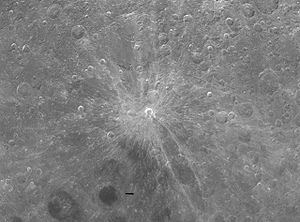Giordano Bruno (moon crater)
| Giordano Bruno | ||
|---|---|---|

|
||
| NASA image of Giordano Bruno crater | ||
|
|
||
| position | 35.92 ° N , 102,74 ° O | |
| diameter | 22 km | |
| Card sheet | 29 (PDF) | |
| Named after | Giordano Bruno (1548–1600) | |
| Named since | 1961 | |
| Unless otherwise stated, the information comes from the entry in the IAU / USGS database | ||
Giordano Bruno is a ray crater with a diameter of 22 kilometers and with this size probably the youngest crater on the moon . It lies just behind the visible part of the moon's surface on the back of the moon.
Age
Giordano Bruno is a fairly young lunar crater. The geologist Jack B. Hartung speculated as early as 1976 that its origin had been recorded by humans: On June 25, 1178, the monk and chronicler Gervasius of Canterbury observed a luminous phenomenon on the crescent moon, which could have been the meteor impact that caused the crater . This theory was criticized early on, as no other reports from the period indicate such an event. Current studies on the number and distribution of small craters in the ejections around Giordano Bruno indicate an older age between 1 and 10 million years. The crater-forming event most likely did not occur within recorded history.
Investigations

On June 23, 2009 it was flown over by the lunar probe LCROSS and examined with various cameras and spectroscopes. Reflection spectra measured at several points in and around the crater show strong absorption bands, which suggest that minerals of the pyroxene group with a high calcium content dominate the geology of the crater.
Web links
- Giordano Bruno in the Gazetteer of Planetary Nomenclature of the IAU (WGPSN) / USGS
- Giordano Bruno crater in the "Digital Lunar Orbiter Photographic Atlas of the Moon"
Individual evidence
- ^ Hartung Jack B .: Was the Formation of a 20-km Diameter Impact Crater on the Moon Observed on June 18, 1178? . In: Meteoritics . 11, No. 3, 1976, p. 187. bibcode : 1976Metic..11..187H . doi : 10.1111 / j.1945-5100.1976.tb00319.x .
- ↑ O. Calame, JD Mulholland: Lunar crater giordano bruno: ad 1178 impact observations consistent with laser ranging results. In: Science. Volume 199, number 4331, February 1978, pp. 875-877, doi : 10.1126 / science.199.4331.875 , PMID 17757584 .
- ^ The Mysterious Case of Crater Giordano Bruno . NASA. Accessed October 2017.
- ^ Tomokatsu Morota et al .: Formation age of the lunar crater Giordano Bruno . In: Meteoritics and Planetary Science . tape 44 , no. 8 , 2009, p. 1115–1120 , doi : 10.1111 / j.1945-5100.2009.tb01211.x .
- ↑ LCROSS RSS feed. NASA, June 23, 2009, accessed June 23, 2009 .
- ↑ Y.Ogawa et al .: The widespread occurrence of high-calcium pyroxene in bright-ray craters on the Moon and implications for lunar-crust composition . In: Geophys. Res. Lett. tape 38 , 2011, p. L17202 , doi : 10.1029 / 2011GL048569 .
